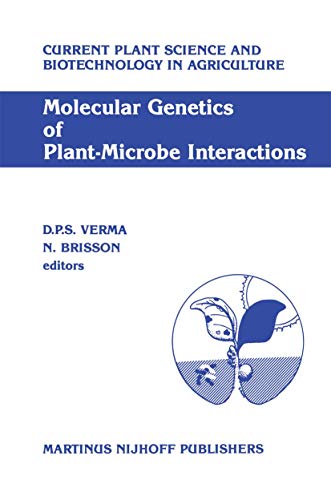Molecular Genetics of Plant-Microbe Interactions: Proceedings of the Third International Symposium on the Molecular Genetics of Plant-Microbe ... Science and Biotechnology in Agriculture, 3) - Hardcover

"synopsis" may belong to another edition of this title.
- PublisherSpringer
- Publication date1986
- ISBN 10 9024734266
- ISBN 13 9789024734269
- BindingHardcover
- Number of pages370
- EditorVerma Desh Pal S., Brisson N.
Buy New
Learn more about this copy
Shipping:
US$ 3.99
Within U.S.A.
Top Search Results from the AbeBooks Marketplace
Molecular Genetics of Plant-Microbe Interactions
Book Description Condition: New. pp. 376. Seller Inventory # 263106427
Molecular Genetics of Plant-Microbe Interactions
Book Description Condition: New. pp. 376 52:B&W 6.14 x 9.21in or 234 x 156mm (Royal 8vo) Case Laminate on White w/Gloss Lam. Seller Inventory # 5822884
Molecular Genetics of Plant-Microbe Interactions: Proceedings of the Third International Symposium on the Molecular Genetics of Plant-Microbe . Science and Biotechnology in Agriculture) [Hardcover ]
Book Description Hardcover. Condition: new. Seller Inventory # 9789024734269
Molecular Genetics of Plant-Microbe Interactions: Proceedings of the Third International Symposium on the Molecular Genetics of Plant-Microbe . Science and Biotechnology in Agriculture, 3)
Book Description Condition: New. Seller Inventory # ABLIING23Apr0316110330259
Molecular Genetics of Plant-Microbe Interactions : Proceedings of the Third International Symposium on the Molecular Genetics of Plant-Microbe Associations; Montrà al; Quà bec; Canada; July 27-31; 198
Book Description Condition: New. PRINT ON DEMAND Book; New; Fast Shipping from the UK. No. book. Seller Inventory # ria9789024734269_lsuk
Molecular Genetics of Plant-Microbe Interactions
Book Description Buch. Condition: Neu. This item is printed on demand - it takes 3-4 days longer - Neuware -Increased interest in the basic biology of plants and microorganisms stems from the fact that crop productivity is directly affected by plant-microbe interactions. In spite of the fact that plants exist in the environment amongst diverse species of microorganisms, only a few ever establish a direct relationship. Emerging awareness concerning the indirect effect of microbial association on plant growth and the possibility of using one microbe against another for controlling pathogenic interactions is at the genesis of new fields of studies. The primary reason for a microbe to associate with photoautotrophic organisms (plants) is to tap its nutritional requirements, fixed carbon, as a source of energy. By hook or by crook, a microbe must survive. Some have evolved mechanisms to exploit plants to develop a niche for their biotropic demands. When in contact with a living plant, microorganisms may live in a passive association using exudates from the plant, invade it pathogenically or coexist with it in symbiosis. The plant responds to the interloper, either reacting in a hypersensitive manner to contain the invasion of pathogens, or by inducing a set of genes that leads toward symbiosis, or by simply succumbing to the invader. Thus, prior to contact wi th the plant, mic roorganism is able to sense the presence of the host and activate accordingly a set of genes required for the forthcoming interaction, whether symbiotic or pathogenic. 374 pp. Englisch. Seller Inventory # 9789024734269
Molecular Genetics of Plant-Microbe Interactions
Book Description Gebunden. Condition: New. Dieser Artikel ist ein Print on Demand Artikel und wird nach Ihrer Bestellung fuer Sie gedruckt. Proceedings of the Third International Symposium on the Molecular Genetics of Plant-Microbe Interactions, Montreal, Quebec, Canada, July 27-31, 1986 Increased interest in the basic biology of plants and microorganisms stems from the fact that crop pro. Seller Inventory # 5813691
Molecular Genetics of Plant-Microbe Interactions : Proceedings of the Third International Symposium on the Molecular Genetics of Plant-Microbe Associations, Montréal, Québec, Canada, July 27¿31, 1986
Book Description Buch. Condition: Neu. Druck auf Anfrage Neuware - Printed after ordering - Increased interest in the basic biology of plants and microorganisms stems from the fact that crop productivity is directly affected by plant-microbe interactions. In spite of the fact that plants exist in the environment amongst diverse species of microorganisms, only a few ever establish a direct relationship. Emerging awareness concerning the indirect effect of microbial association on plant growth and the possibility of using one microbe against another for controlling pathogenic interactions is at the genesis of new fields of studies. The primary reason for a microbe to associate with photoautotrophic organisms (plants) is to tap its nutritional requirements, fixed carbon, as a source of energy. By hook or by crook, a microbe must survive. Some have evolved mechanisms to exploit plants to develop a niche for their biotropic demands. When in contact with a living plant, microorganisms may live in a passive association using exudates from the plant, invade it pathogenically or coexist with it in symbiosis. The plant responds to the interloper, either reacting in a hypersensitive manner to contain the invasion of pathogens, or by inducing a set of genes that leads toward symbiosis, or by simply succumbing to the invader. Thus, prior to contact wi th the plant, mic roorganism is able to sense the presence of the host and activate accordingly a set of genes required for the forthcoming interaction, whether symbiotic or pathogenic. Seller Inventory # 9789024734269

